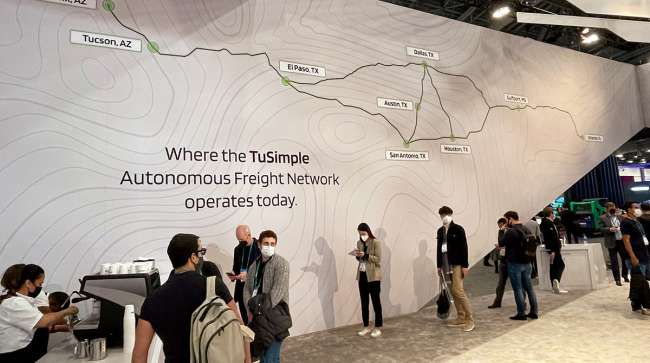Managing Editor, Features and Multimedia
After ‘Driver-Out’ Milestone, TuSimple CEO Cheng Lu Outlines Vision for Autonomous Trucking

[Find the latest in trucking technology: Explore this quarter's issue of iTECH]
LAS VEGAS — When TuSimple completed its first “driver-out” autonomous truck run in December, it marked a significant step toward a commercial launch of the company’s driverless truck technology.
That unmanned test run, which covered an 80-mile route on highways and surface streets in Arizona, was “a big milestone for us and for the industry,” TuSimple CEO Cheng Lu told Transport Topics. “It was done without any intervention of traffic, without any humans on board and without any remote control of the vehicle.”
MARCH 4 UPDATE: Xiaodi Hou succeeds Cheng Lu as CEO
The demonstration broke new ground for TuSimple’s autonomous truck operations, which up to that point had always involved a safety driver behind the wheel as backup while testing on public roads.
A couple of weeks later, TuSimple highlighted that fully autonomous run as part of its exhibit at CES 2022 in Las Vegas, where the company not only displayed a Class 8 International tractor equipped with its technology but also presented a “holistic” picture of autonomous trucking operations.

TuSimple’s Cheng Lu describes autonomous trucking as a new mode of transportation. (TuSimple)
The exhibit mapped out the routes covered by TuSimple’s expanding autonomous freight network, while also illustrating a terminal layout designed for driverless trucks, a vehicle monitoring system for an autonomous fleet and protocols for human-to-machine interactions.
“At TuSimple, our mission is to automate certain routes that make the most sense to automate — and those are longhaul applications, the ones that have greater distance, a lot of repetition,” said Lu, who outlined the company’s vision for autonomous trucking during a Jan. 5 interview at the major technology show.
More Q1 iTECH
►How Fleets Are Winning the Race to Hire Drivers
►Clevenger: High-Tech Recruiting Battles
►Dysart: Auto-Written Trend Reports: Fleet Insights in Clear Words
►Q&A: Yellow's Jason Ringgenberg
Explore the Issue!
He likened autonomous trucking to a new mode of transportation that can help make the overall supply chain more efficient.
“It frees up valuable driver resources and valuable freight capacity to other parts of the logistics network — first-mile, last-mile, stuff it doesn’t make sense to automate,” Lu said.
To commercialize its technology, TuSimple aims to begin continuous unmanned freight operations by the end of 2023 and then, over time, scale up its operations across the country.
“By 2030, we hope to have 100,000 autonomous trucks operating on the TuSimple autonomous driving system nationwide in the U.S.,” Lu said.
In February, the San Diego-based company announced additional steps toward realizing those goals.
TuSimple said it already has expanded its “driver-out” program with several more fully autonomous runs.
It also announced that Union Pacific Railroad will become its first customer to move freight via TuSimple’s fully automated route in Arizona linking Tucson and Phoenix. Those unmanned truck deliveries are set to begin in the spring, the companies said.
Although TuSimple is planning to expand its autonomous freight network across the United States, it is focusing on middle-mile applications that are best suited to the technology.

TuSimple displays a Class 8 International tractor outfitted with its technology at CES 2022 in Las Vegas. (Seth Clevenger/Transport Topics)
“Autonomy makes sense on certain lanes,” Lu said. “It’s not going to be everywhere.”
Rather than replacing professional truck drivers, autonomous trucks will complement the industry’s workforce and could even create more desirable driving jobs in the future, he said.
In fact, Lu said he firmly believes that any professional driver working today will be able to retire as a driver, “without question.”
The rollout of autonomous trucks in some lanes could enable the industry to shift more human drivers into jobs that allow them to return home at night, he said.
At the same time, freight volumes are rising and consumer expectations are driving the transportation industry toward faster delivery times.
“This is not a zero-sum game. The demand for truck freight is actually increasing,” Lu said. “All of us want goods delivered to our houses today [or] tomorrow — definitely not a week from now — and that’s putting a lot of pressure on the supply chain.”
Apart from its growing U.S. operations, TuSimple also is deploying autonomous trucks in other markets across the globe, including China and Europe.
But Lu expects autonomous trucking to take hold in the United States first.
He said the U.S. trucking industry is ripe for this technology due to factors such as high driver turnover and long stretches of open highways and freight corridors that are conducive to autonomous operation, along with a favorable regulatory environment.
Today, it might take five or six days for a manually driven truck to travel from coast to coast due to driver hours-of-service limitations, but that trip could be completed in as little as two days with an autonomous truck because it could operate 20 hours a day, Lu said.
“We’re big believers that the U.S. will be the first to commercialize the technology,” Lu said.
Want more news? Listen to today's daily briefing below or go here for more info:





